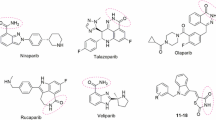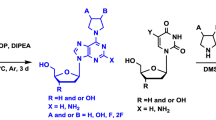Abstract
We show for the first time that natural 2,5-diketopiperazines (cyclic dipeptides) can suppress the activity of the important anticancer target poly(ADP-ribose)polymerase (PARP). Cyclo(L-Ala-L-Ala) and cyclo(L-Ala-D-Ala) can interact with the key residues of the PARP-1 active site, as demonstrated using docking and molecular dynamics simulations. One of the amide groups of cyclo(L-Ala-L-Ala) and cyclo(L-Ala-D-Ala) forms hydrogen bonds with the Gly863 residue, while the second amide group can form a hydrogen bond with the catalytic residue Glu988, and the side chain can make a hydrophobic contact with Ala898. Newly identified diketopiperazine inhibitors are promising basic structures for the design of more effective inhibitors of PARP family enzymes. The piperazine core with two chiral centers provides many opportunities for structural optimization.
Similar content being viewed by others
Abbreviations
- PARP:
-
poly(ADP-ribose)polymerase.
References
Prasad, C. (1995) Bioactive cyclic dipeptides, Peptides, 16, 151–164.
Minelli, A., Bellezza, I., Grottelli, S., and Galli, F. (2008) Focus on cyclo(His-Pro): history and perspectives as antioxidant peptide, Amino Acids, 35, 283–289.
Borthwick, A. D., and Da Costa, N. C. (2017) 2,5-Diketopiperazines in food and beverages: taste and bioactivity, Crit. Rev. Food Sci. Nutr., 57, 718–742.
Martins, M. B., and Carvalho, I. (2007) Diketopiperazines: biological activity and synthesis, Tetrahedron, 63, 9923–9932.
Borthwick, A. D. (2012) 2,5-Diketopiperazines: synthesis, reactions, medicinal chemistry, and bioactive natural products, Chem. Rev., 112, 3641–3716.
Dinsmore, C. J., and Beshore, D. C. (2002) Recent advances in the synthesis of diketopiperazines, Tetrahedron, 58, 3297–3312.
Rodionov, I. L., Rodionova, L. N., Baidakova, L. K., Romashko, A. M., Balashova, T. A., and Ivanov, V. T. (2002) Cyclic dipeptides as building blocks for combinatorial libraries. Part 2: Synthesis of bifunctional diketopiperazines, Tetrahedron, 58, 8515–8523.
Khimiuk, A. Y., Korennykh, A. V., Van Langen, L. M., Van Rantwijk, F., Sheldon, R. A., and Švedas, V. K. (2003) Penicillin acylase-catalyzed peptide synthesis in aqueous medium: a chemo-enzymatic route to stereoisomerically pure diketopiperazines, Tetrahedron Asymmetry, 14, 3123–3128.
Coward, R. M., and Carson, C. C. (2008) Tadalafil in the treatment of erectile dysfunction, Ther. Clin. Risk Manag., 4, 1315–1330.
Borthwick, A. D. (2010) Oral oxytocin antagonists, J. Med. Chem., 53, 6525–6538.
Watson, C., Jenkinson, S., Kazmierski, W., and Kenakin, T. (2005) The CCR5 receptor-based mechanism of action of 873140, a potent allosteric noncompetitive HIV entry inhibitor, Mol. Pharmacol., 67, 1268–1282.
Nicholson, B., Lloyd, G. K., Miller, B. R., Palladino, M. A., Kiso, Y., Hayashi, Y., and Neuteboom, S. T. (2006) NPI-2358 is a tubulin-depolymerizing agent: in vitro evidence for activity as a tumor vascular-disrupting agent, Anticancer Drugs, 17, 25–31.
Hayashi, Y., Yamazaki-Nakamura, Y., and Yakushiji, F. (2013) Medicinal chemistry and chemical biology of diketopiperazine-type antimicrotubule and vascular-disrupting agents, Chem. Pharm. Bull. (Tokyo), 61, 889–901.
Hassa, P. O., Haenni, S. S., Elser, M., and Hottiger, M. O. (2006) Nuclear ADP-ribosylation reactions in mammalian cells: where are we today and where are we going, Microbiol. Mol. Biol. Rev., 70, 789–829.
Hassler, M., and Ladurner, A. G. (2012) Towards a structural understanding of PARP1 activation and related signaling ADP-ribosyl-transferases, Curr. Opin. Struct. Biol., 22, 721–729.
Drenichev, M. S., and Mikhailov, S. N. (2016) Poly(ADP-ribose): from chemical synthesis to drug design, Bioorg. Med. Chem. Lett., 26, 3395–3403.
Cepeda, V., Fuertes, M. A., Castilla, J., Alonso, C., Quevedo, C., Soto, M., and Perez, J. M. (2006) Poly(ADP-ribose) polymerase-1 (PARP-1) inhibitors in cancer chemotherapy, Recent Pat. Anticancer Drug Discov., 1, 39–53.
Curtin, N. J., and Szabo, C. (2013) Therapeutic applications of PARP inhibitors: anticancer therapy and beyond, Mol. Aspects Med., 34, 1217–1256.
Farmer, H., McCabe, N., Lord, C. J., Tutt, A. N., Johnson, D. A., Richardson, T. B., Santarosa, M., Dillon, K. J., Hickson, I., Knights, C., Martin, N. M., Jackson, S. P., Smith, G. C., and Ashworth, A. (2005) Targeting the DNA repair defect in BRCA mutant cells as a therapeutic strategy, Nature, 434, 917–921.
Martin, S. A., Lord, C. J., and Ashworth, A. (2008) DNA repair deficiency as a therapeutic target in cancer, Curr. Opin. Genet. Dev., 18, 80–86.
Ame, J. C., Spenlehauer, C., and De Murcia, G. (2004) The PARP superfamily, Bioessays, 26, 882–893.
Schreiber, V., Dantzer, F., Ame, J. C., and De Murcia, G. (2006) Poly(ADP-ribose): novel functions for an old molecule, Nat. Rev. Mol. Cell Biol., 7, 517–528.
Jagtap, P., and Szabo, C. (2005) Poly(ADP-ribose) polymerase and the therapeutic effects of its inhibitors, Nat. Rev. Drug Discov., 4, 421–440.
Ferraris, D. V. (2010) Evolution of poly(ADP-ribose) polymerase-1 (PARP-1) inhibitors. From concept to clinic, J. Med. Chem., 53, 4561–4584.
Malyuchenko, N. V., Kotova, E. Y., Kulaeva, O. I., Kirpichnikov, M. P., and Studitskiy, V. M. (2015) PARP1 inhibitors: antitumor drug design, Acta Naturae, 7, 27–37.
Banasik, M., and Ueda, K. (1994) Inhibitors and activators of ADP-ribosylation reactions, Mol. Cell. Biochem., 138, 185–197.
Frampton, J. E. (2015) Olaparib: a review of its use as maintenance therapy in patients with ovarian cancer, BioDrugs, 29, 143–150.
Sehouli, J., Braicu, E. I., and Chekerov, R. (2016) PARP inhibitors for recurrent ovarian carcinoma: current treatment options and future perspectives, Geburtshilfe Frauenheilkd., 76, 164–169.
Wang, Y. Q., Wang, P. Y., Wang, Y. T., Yang, G. F., Zhang, A., and Miao, Z. H. (2016) An update on poly(ADP-ribose)polymerase-1 (PARP-1) inhibitors: opportunities and challenges in cancer therapy, J. Med. Chem., 59, 9575–9598.
Nilov, D. K., Tararov, V. I., Kulikov, A. V., Zakharenko, A. L., Gushchina, I. V., Mikhailov, S. N., Lavrik, O. I., and Švedas, V. K. (2016) Inhibition of poly(ADP-ribose)polymerase by nucleic acid metabolite 7-methylguanine, Acta Naturae, 8, 108–115.
Sletten, E. (1970) Conformation of cyclic dipeptides. The crystal and molecular structures of cyclo-D-alanyl-L-alanyl and cyclo-L-alanyl-L-alanyl (3,6-dimethylpiperazine-2,5-dione), J. Am. Chem. Soc., 92, 172–177.
Stroganov, O. V., Novikov, F. N., Stroylov, V. S., Kulkov, V., and Chilov, G. G. (2008) Lead finder: an approach to improve accuracy of protein–ligand docking, binding energy estimation, and virtual screening, J. Chem. Inf. Model., 48, 2371–2385.
Novikov, F. N., Stroylov, V. S., Stroganov, O. V., Kulkov, V., and Chilov, G. G. (2009) Developing novel approaches to improve binding energy estimation and virtual screening: a PARP case study, J. Mol. Model., 15, 1337–1347.
Case, D. A., Darden, T. A., Cheatham, T. E., Simmerling, C. L., Wang, J., Duke, R. E., Luo, R., Walker, R. C., Zhang, W., Merz, K. M., Roberts, B., Hayik, S., Roitberg, A., Seabra, G., Swails, J., Gotz, A. W., Kolossvary, I., Wong, K. F., Paesani, F., Vanicek, J., Wolf, R. M., Liu, J., Wu, X., Brozell, S. R., Steinbrecher, T., Gohlke, H., Cai, Q., Ye, X., Wang, J., Hsieh, M.-J., Cui, G., Roe, D. R., Mathews, D. H., Seetin, M. G., Salomon-Ferrer, R., Sagui, C., Babin, V., Luchko, T., Gusarov, S., Kovalenko, A., and Kollman, P. A. (2012) AMBER 12, University of California, San Francisco.
Case, D. A., Cheatham, T. E., 3rd, Darden, T., Gohlke, H., Luo, R., Merz, K. M., Jr., Onufriev, A., Simmerling, C., Wang, B., and Woods, R. J. (2005) The Amber biomolecular simulation programs, J. Comput. Chem., 26, 1668–1688.
Voevodin, V. V., Zhumatiy, S. A., Sobolev, S. I., Antonov, A. S., Bryzgalov, P. A., Nikitenko, D. A., Stefanov, K. S., and Voevodin, V. V. (2012) Practice of “Lomonosov” super-computer, Open Systems J. (Moscow), 7, 36–39.
Hornak, V., Abel, R., Okur, A., Strockbine, B., Roitberg, A., and Simmerling, C. (2006) Comparison of multiple Amber force fields and development of improved, Proteins, 65, 712–725.
Crowley, M. F., Darden, T. A., Cheatham, T. E., and Deerfield, D. W. (1997) Adventures in improving the scaling and accuracy of a parallel molecular dynamics program, J. Supercomput., 11, 255–278.
Humphrey, W., Dalke, A., and Schulten, K. (1996) VMD–visual molecular dynamics, J. Mol. Graph., 14, 33–38.
Kinoshita, T., Nakanishi, I., Warizaya, M., Iwashita, A., Kido, Y., Hattori, K., and Fujii, T. (2004) Inhibitor-induced structural change of the active site of human poly(ADP-ribose) polymerase, FEBS Lett., 556, 43–46.
Wahlberg, E., Karlberg, T., Kouznetsova, E., Markova, N., Macchiarulo, A., Thorsell, A. G., Pol, E., Frostell, A., Ekblad, T., Oncu, D., Kull, B., Robertson, G. M., Pellicciari, R., Schuler, H., and Weigelt, J. (2012) Family-wide chemical profiling and structural analysis of PARP and tankyrase inhibitors, Nat. Biotechnol., 30, 283–288.
Ekblad, T., Lindgren, A. E., Andersson, C. D., Caraballo, R., Thorsell, A. G., Karlberg, T., Spjut, S., Linusson, A., Schuler, H., and Elofsson, M. (2015) Towards small molecule inhibitors of mono-ADP-ribosyltransferases, Eur. J. Med. Chem., 95, 546–551.
Stark, T., and Hofmann, T. (2005) Structures, sensory activity, and dose/response functions of 2,5-diketopiperazines in roasted cocoa nibs (Theobroma cacao), J. Agric. Food Chem., 53, 7222–7231.
Stark, T., Bareuther, S., and Hofmann, T. (2006) Molecular definition of the taste of roasted cocoa nibs (Theobroma cacao) by means of quantitative studies and sensory experiments, J. Agric. Food Chem., 54, 5530–5539.
Chen, Y. H., Liou, S. E., and Chen, C. C. (2004) Two-step mass spectrometric approach for the identification of diketopiperazines in chicken essence, Eur. Food Res. Technol., 218, 589–597.
Li, X. J., Tang, H. Y., Duan, J. L., Gao, J. M., and Xue, Q. H. (2013) Bioactive alkaloids produced by Pseudomonas brassicacearum subsp. neoaurantiaca, an endophytic bacterium from Salvia miltiorrhiza, Nat. Prod. Res., 27, 496–499.
Author information
Authors and Affiliations
Corresponding author
Additional information
Published in Russian in Biokhimiya, 2018, Vol. 83, No. 2, pp. 251-258.
Electronic supplementary material
Rights and permissions
About this article
Cite this article
Nilov, D.K., Yashina, K.I., Gushchina, I.V. et al. 2,5-Diketopiperazines: A New Class of Poly(ADP-ribose)polymerase Inhibitors. Biochemistry Moscow 83, 152–158 (2018). https://doi.org/10.1134/S0006297918020074
Received:
Revised:
Published:
Issue Date:
DOI: https://doi.org/10.1134/S0006297918020074




